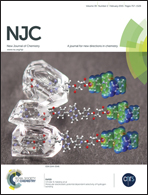Chiral anion recognition by a ureido-thiacalix[4]arene ligand immobilized in the 1,3-alternate conformation†
Abstract
While all the alkylation methods commonly used in the chemistry of classical calixarenes failed, tetranitrothiacalix[4]arene was easily alkylated using various alcohols under Mitsunobu reaction conditions. The products thus obtained were immobilized in the 1,3-alternate conformation as suggested by 1H NMR and proven unequivocally by X-ray analysis. The introduction of chiral alkyl substituents into the lower rim of thiacalixarene gave us an opportunity to form well-preorganized ureido cavities on both sites of the system. As revealed by 1H NMR titration experiments, such compounds were capable of chiral anion recognition even in DMSO-d6 which is a highly competitive solvent towards hydrogen bonding interactions. The highest chiral discrimination was achieved for free serine with a selectivity factor of 3.13 for the D-isomer.
![Graphical abstract: Chiral anion recognition by a ureido-thiacalix[4]arene ligand immobilized in the 1,3-alternate conformation](/en/Image/Get?imageInfo.ImageType=GA&imageInfo.ImageIdentifier.ManuscriptID=C4NJ01956C&imageInfo.ImageIdentifier.Year=2015)

 Please wait while we load your content...
Please wait while we load your content...